#Homebrew Variant
Explore tagged Tumblr posts
Text
Good news and bad news on the Balor variant frame.
The bad news is that I am very bad at making unique mechanics and balance. All I'm good at is writing 30 pages of in-depth lore and character backstory.
THE GOOD NEWS IS THAT I GOT MY BUDDY WHO'S GOOD AT GAME MECHANICS HOOKED ON THE 30 PAGES OF FLAVOR TEXT AND NOW WE'RE BOTH MAKING THE VARIANT FRAME!
It's name is Charybdis. It has a built-in NHP that is very hungry always.
#lancer#lancer rpg#lancer ttrpg#lancer balor#balor#ttrpg#mech#mecha#lancer frame#lancer variant#lancer homebrew
40 notes
·
View notes
Note
would you like to share some of your dnd homebrew? :-)
(author's choice!)
YOU (general you not you specifically) MAY HAVE THOUGHT MY DND HYPERFIXATION WAS BHAALSPAWN. OR FIENDS. OR ELVES.
MAYHAPS YOU NOTICED MY LOVE OF ILLITHIDS AND ABOLETHS AND FIGURED I WAS ACTUALLY AN ABBERATION STAN.
WRONG. ALL OF YOU.
ITS FAERIES.

WOE! FAERIE HOMEBREW LORE BE UPON YE
Faerie Lore And How It Applies To YOU
-Archfey are broadly aligned to two courts. The Seelie Court, ruled by Titania, Queen of Summer, and the Gloaming Court, ruled by the Queen of Air and Darkness. The two are on somewhat friendly terms, and often engage in good sport competition with each other. Fey can choose to align with either of these courts, or strike out as independent.
-Court Fey enjoy several benefits, such as allies and manpower, but are also beholden to the relationships of power within that court, even ones that do not directly involve them. Independent fae do not have access to these resources, but their allies and their enemies are solely their own.
-The Seelie Court is associated with the warm half of the year and the season Summer, and on the whole embodies active change, that which changes because you influence it. Culturally, the Seelie Court is known for their decadent and hedonistic lifestyle, valuing passion and excitement above all else, and will take any excuse to party and celebrate to excess.
-The Gloaming Court is associated with the colder half of the year and the season Winter, and on the whole embodies passive change, that which changes without your influence, such as the passing of seasons or the growth and decay of nature. Culturally, the Gloaming Court is known to be more restrained and melancholic, and while still prone to the decadence inherent to all Fey, they take a particular delight in guilty pleasures, and that hidden behind closed doors. Instead of the unrestrained festivities of the Seelie Court, the Gloaming is known for several annual balls and masquerades.
-Archfey embody certain specific concepts found in existence. While a god may embody “Life” or “Death”, an archfey will embody something like “the feeling of being caught between two somethings, such as the two halves of one’s heritage, or the in-between space between planes”.
-The more powerful an archfey, the broader and more encompassing their domain. A weaker fey may embody something as “this specific tree I reside in”, a weak archfey may embody something like “the feeling of creating something from clay”, but Titania, the Queen of the Seelie Court and an entity of near God-like power, embodies the entire breadth and width of the concept and reality of Summer, the pleasure, the hedonism, the heat, the storms, the leisure, and the tragedy.
-As long as a concept exists in this world, when the Archfey embodying it is slain, they will inevitably be reborn. While there isn’t an Archfey embodying *every* concept, the older a concept is, such as ones found in nature like the seasons, the more likely it is for an Archfey to govern it.
-An Archfey may shift their perspective or the aspects of their embodying concept throughout their life, although being reborn almost always results in a shift in personality and thought. As a result, even fey aligned with the more positive and uplifting Seelie court can be cruel and malicious. An Archfey may embody the concept of “gatherings that bring you joy” but instead shift their focus to “gatherings of evil people that delight in causing suffering”. While the overall concept is the same (they still embody gatherings that bring you joy), the focus is drastically different, and thus so is their behavior.
-The language of Fey, Sylvan, reflects their natural, conceptual origins. To speak Sylvan is to communicate a concept in its breadth of your understanding to another person. In this sense, one cannot say something that they do not believe or does not exist, as the concept for it would also not exist. Thus, lying is impossible in Sylvan, and other means of deception must be employed instead.
-For this reason, Fey became masters of circular logic and twisting words to deceive others. This is also what led to the perception of Fey themselves being unable to lie. This however, is not true. A fae is perfectly capable of lying in any other language, and some will even take advantage of that perception.
-Titania travels in a travelling procession, her court a constantly moving caravan, as she brings the entirety of her retainers, attendants, advisors, knights, cooks, musicians, and a retinue of followers who are free to travel alongside or leave as they desire. While she does visit some locations with regularity, Titania mostly travels the breadth of the continent as she whims, making locating her a matter of luck rather than skill. Despite the massive procession of traveling carts, Titania’s presence invigorates and replenishes the surrounding nature, and the damage wrought by the many wheels and hooves is healed in moments after they’re gone.
-By contrast, the Queen of Air and Darkness resides in a castle set far into the frozen north, hidden deep within the mountainous taiga. She communicates exclusively through an artifact known as the Black Diamond, and her name and appearance are unknown to all.
-Archfey are powerful enough to have their own demiplane, nestled within the Feywilds. These are known colloquially as Wonderlands, though some may have their own names. These spaces are made by the sheer power held by the Archfey and are entirely at their whim. The architecture, the wildlife, the local flora, everything within exists at the behest of the Archfey. Some Wonderlands have existed for so long that, suffused with power as they are, they begin to produce their own Fey native within.
-Fey have an inherent appreciation and adoration of beauty, but the manner they define it is different from mortal perceptions. Being entities of nature and concept as they are, to a fae, what is “beautiful” is less determined by physical appearance (which is transient and varied, and thus entirely secondary to beauty) and more by the expression of one’s true self, and the natural changes one goes through during their life, both physically and emotionally.
-One who acts according to one’s nature is “good” and “beautiful”, while those who strain against it and fight it, to be someone they are not, have their beauty diminished. Those who work to corrupt and twist people away from their true natures are “evil” and “ugly”. Hags are considered hideous to Fey because of their love of corruption, and twisting those with strong convictions and beliefs. The Hag’s repugnant physical appearance isn’t even considered a factor to other Fey.
-In that sense, beauty to a fey is not limited by personal alignment. An Evil Aligned person can be considered beautiful to a fae, as long as they don’t restrain their true natures. However, if that person also seeks to corrupt and twist the natures and selves of other people, a fae may find them hideous.
-Manipulation and taking advantage of others' natures is not considered ugly, as it is the natural way of things, generally. All living things manipulate each other for their own and others benefits, and the action is considered neutral.
-Beauty is also in change. Fey are born with a connection to Chaos, and as such are aligned with Chaotic ideologies, and above all value change and freedom. As such, one's nature is expected to change, and their beauty along with it. Stagnation, especially forced stagnation, is considered hideous, be it in nature or in one’s self. By denying the truth of yourself, by ignoring it, or fighting it, you corrupt that which makes the world beautiful.
-By nature, fey are also tricksters and bargain makers. While their keen senses are honed towards the art of debate and verbal battle, a fey can be tricked or manipulated by the promise of bargains or deals. This aspect is one of their greatest strengths, and most vulnerable weaknesses. One does not defeat a fae by a battle of swords, but through a battle of wits, and as such even a child is capable of besting them, yet even mighty warlords may be laid low.
-One of the more extraordinary senses of the Fey is their ability to sense one’s true self, and how in line the person currently is with it. This is best embodied by the Sprite’s heart sense, as they have taken this perception and refined it to the point of being able to glean mood, and even alignment. For others, it is akin to a tingling sense that the person they’re engaging with is restraining or battling themselves in some way. They appear “off” or “sideways”.
-Fey often speak in metaphor, used to the lilting concept of Sylvan as they are, and phrase things strangely, though those with frequent interactions with mortals may adjust their vernacular to something more appropriate or understandable.
-Fey have a keen awareness of the dynamics of power between themselves and the person they’re engaging with, and use this sense to guide conversation and action accordingly, although their perceptions of power differ from typical mortal understandings. Power is determined by who is doing what, at whom’s behest. When you ask someone to do something for you, you are giving them a modicum of power over you, as you now rely on them. As such, servantry positions are highly respected, and disrespect towards the servants or the work they do is seen as incredibly rude, disrespecting not only the servant but the host they work for.
-A Fae with a great deal of political power may boast by having a large retinue of servants, indicating that they feel free to give so much power away to show that it does not threaten them. On the other hand, a lack of servants may indicate paranoia. As servantry is a highly respected position that comes with an amount of power from the host, servant positions for the most powerful Archfey are often declined, due to the sheer amount of pressure and responsibility foisted upon them. Taking power from Titania is incredibly stressful, as you now have a responsibility to use that power appropriately, befitting the Queen of Summer. Very few will seek that position out, and Titania usually has to request servants personally.
-It is because of this that manners are so intricate, and that violating them has such severe consequences. Partaking of a meal offered to you without negotiating a means of repayment means that you have taken power that was not yours, and that now a debt is owed, in addition to the disrespect paid, which exacerbates the punishment. You have disrespected the servantry, both the cooks and the servers, by eating before permission was given, thus disrespecting the work it took to create the food and serve it to you. You have disrespected the host, by disrespecting their servants, and by ignoring courtesy by taking what was not yet yours, that you had no right to, and further by declining to engage in good faith negotiation that would treat your host as an equal, instead simply taking it and by doing so indicating that you believe your host beneath you. And finally, you have created a debt with no set terms, by not negotiating repayment beforehand, even simply in good hospitality, that the host is now free to determine as they please. Hence such a drastic punishment, such as no longer being capable of leaving, being cursed to no longer gain sustenance from non faerie foods, falling into an eternal slumber, or being transformed into a pig for their gluttony. While it is commonly believed that the food of faerie possesses such extraordinary tastes as to render other food inedible, in truth it is simply the curse of impoliteness that binds one.
-Because the Fey have such a strong focus on being true to oneself, this also translates into an ambition that reaches only as far as it feels right. Overstepping one’s bounds, reaching too far, or selling oneself short are all anathema to true fey. While a fiend may have unbridled ambition, seeking the position that is on top, a fae instead seeks for the position that's right. Not too high, not too low, a position that both caters to one's natural talents, but also provides just the right amount of challenge, providing plenty of opportunity to grow and change, but not so much that it is an impossible standard to meet.
-All of these contribute to an overwhelming amount of Fey pact warlocks. Archfey have an inborn inclination to bargain and deal, and for a patron, the sheer amount of power wielded feels like a kettle about to overflow. There is a strong drive to seek out those with the inclination to make a pact, or simply those with a particularly eye catching appeal to them. Warlocks are born, not made, after all. As such, Archfey will often bring non fey into the circle of Sylvan politics, sometimes just as trophies to show that they can divide their power amongst so many and remain undaunted. Other times, it is because the Archfey seeks agents to help enact its schemes and to carry its will beyond its Wonderland into the Material. None of this necessarily means that the warlock is informed of its newfound position in the sprawling hierarchy of faerie power dynamics, which often leads to an early death.
-Some Fey Pact Warlocks have taken it upon themselves to correct this issue, by founding an academy that seeks to educate newly pacted warlocks upon their newfound position and responsibilities.
#theo homebrews lore#<- NEW TAG FOR THIS#maud-lin#ITS NOT LIKE WOTC CARES ABOUT FAERIES OR THE FEYWILD.#MY. CITY. NOW.#note. all of this was written in 2016. NOTABLY WELL BEFORE WILD BEYOND THE WITCHLIGHT#so i HAVENT UPDATED IT#i was in a massive depressive period when WBTW dropped i couldnt touch my lore#BUT NOTABLY. IM PRIMARILY A WORLDBUILDER WRITER#sidenote. if anyone has the miku variant of that pipebomb meme. id love it
5 notes
·
View notes
Video
youtube
ZX Puyo for the ZX81
#youtube#ZX Puyo#ZX81#Puzzle#Falling Blocks Puzzle#Falling Block Puzzle#Tile-matching Puzzle#Puyo Puyo#Puyo Puyo Clone#Puyo Puyo Variant#Homebrew#Homebrew Game#DUH Productions
3 notes
·
View notes
Text

My superhero character in a VERY home brew mutant and mastermind campaign I’m playing, does he count as my spidersona?(eveyone’s character Is also cool I might post them too)
#digital art#drawing#art#doodle#oc#oc art#dnd campaign#dnd homebrew#dnd character#dnd oc#ttrpg art#ttrpg oc#spiderman#spidersona#spider man oc#Spider-Man variant#spider man fanart#superhero#superhero oc
6 notes
·
View notes
Text
what if. revivify variant that doesn't rely on a diamond but another type of sacrifice. like instead of gp cost its a prized possession, a coveted memory, at its most extreme another life, etc. for it still to have a cost outside roleplay a few ideas are a permanent hp decrease, a curse that is either uncurable or requires a side quest to get rid of, permanent spell slot decrease, etc
#im thinking about making a good chunk of 5e variants#to add complexity and customization#dnd#d&d#dnd 5e#dnd homebrew#homebrew#dnd 5e homebrew#dnd5e#dungeons and dragons
16 notes
·
View notes
Text
Combat Variation
We all know the classic way to run combat. In the win state, enemies are unconscious or dead, and the players lose if they're unconscious or dead. This is an excellent way for combat to work. However, it gets tiring after a while. Like eating Mac and chees without any exceptions. I like macaroni, but I'd eventually want something else besides mac and cheese. The same goes for the runaway variety of fights where they're meant to run away. At that point, I don't consider it a fight, more a combat-themed obstacle. ( I am drawing inspiration from the "D&D Combat is boring (and how to fix it)" video by Pointy Hat, "4 ways To make DnD combat Less boring" by Aromas, and " Fixing my BORING D&D combat" by Ginny Di. These videos give good advice regardless of systems, but I will be adjusting descriptions for Dc20)
Disclaimer: Let's make something clear, the bonk till they're dead method of combat is still valid! not every fight should be these new fights. Doing that would just have the same problem as regular combat. Sometimes having mac and cheese is fun and fine. These are meant to be interesting.
Change the target
The winner of the fight is the one that brings one thing to 0 hp. not the first one who brings everyone to zero hp, but a specific target. This changes the strategy of the battle. This can let the players be more aggressive towards one target. Bonus points if the players have something similar to an escort quest. You can also do a combat sport where the winner is the first team to kill the majority of another team's constructs.
Reach the goal
Basically, a rase. Reach the goal before anyone else. Is it more advantageous to cast spells or trigger abilities to use movements, or do they use them to disadvantage the enemy team? Suddenly difficult terrain is a much bigger deal. I can also see it when the players need a cart to cross the finish line and not just the players. Making a target to slow down the enemy carts. like two parties rushing to a one-charge portal with vital supplies in a minecart, but they know damn well the enemy team's gonna close that portal the second their cart is on the other side.
Sports
This is something that relies on being a sport atop regular combat. Using agility to pass goals and Might to body check and guard against the enemy team. I often use soccer as a reference (Not just because Pointy Hat did it, but because I do have no experience besides soccer with the additional experience with basketball). Each team has a ball, and the goal is to throw a goal.
Elemental typings
It's a Cliche, but having certain damage deel extra to enemies can make the Pcs really get into experimentation. Maybe you can even have damage or affect immunity. For this, I recommend a vulnerability for every two immunities.
Centerpieces
This could be a fountain in the main square that provides cover and blocks line of sight, it could be an unstable weapon that has a charge and is fought between the players and enemies, or maybe a river that bisects the battle and the enemies having range weapons on the other side. With a change in the environment Halfway through, like the river flooding, while anyone near the two closed spaces by the river is knocked prone, while a tree near the river becomes able to be tipped over into a reliable bridge with a might check.
Narratives in Combat
Sure, if you have obstacles like bandits and guards standing in your way, but make the obstacles negatively charged. Like maybe they're trying to kill an NPC the PCs have been hired or have an interest in protecting (Bonus points if the players like the NPC). Add a third faction that is fighting both the party and their enemies at the same time (And if you wanna make it more spicy, can they be negotiated with?). Even the enemies' moral failing and the survivors fleeing from the fight can change how the combat goes.
Interactivity
Put stuff that can be interacted with! Furniture can be knocked over to act like cover, barricades, or just get in the way. Bridges can be cut to prevent being followed, drop people on the bridge into the abyss below, or stop people from retreating. Horces can be spooked to cause chaos or prevent escape.
Cover
Enemies should use cover to force movement, you can't just lob fire from a doorframe if you can't see the target. Use pillers, bushes doorframes, wrecked, ruins, trees, giant corpses and more can be used for this.
Zones
Combat doesn't have to be limited to a single zone. People may come in from outside the zone from other rooms, they may push the players outside that zone, they could have people from the upper floors shooting through the floor to try and shoot people on the lower floors, could be in a tunnel where range and shields are king, up the stairs and through portals.
Entry points
It's tempting to make things linear. Maybe some environments don't have as much linearity. Where enemies can come up behind players, and allies can pop up at any moment from unexpected locations.
Change
Even an interesting place can get boring after a while. So something being lit on fire and speeding could be fun, or parts of the architecture are destroyed and block a path or make difficult terrain.
Monster goal variations
As a GM, I know the temptation to just have monsters fight with the same objective. However, there isn't much overlap between how bandits fight and how guards fight. And neither would fight the same way as a powerful Magic user. Along with what their goals are. Like, what's a bandit's goal? Get some loot and make it out alive and without being put in prison. What's a Gaurd's goal? To protect their charge, not die, and get at least one living person to interrogate after the fact. What is a Mage's goal? Service and don't run out of spells. Another example is wolves. They'll act differently if they're starving and looking for food, compared to them defending their den. Even then, how important is this to them? The bandits are likely to bult early if they're not willing to die, in comparison to the guards who will die for that salllerly.
Tactical creatures
Most monsters and people follow at least basic survival instincts, and smarter ones may use simple tactics. They may also try and alter their actions to avoid things. Remember though, this doesn't mean the enemies should be guaranteed a win. the players are the characters at the center of the story unless they mess up hard, it should be beatable and have the players feel smart.
#ttrpg community#combat#Dc20#TTRPG combat#Don't bite off more than you can chew#Combat Variants#DC20#homebrew
2 notes
·
View notes
Text
Mass Effect 5e Alignment Chart
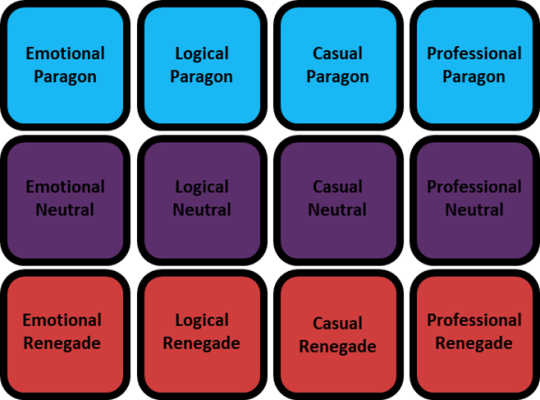
Here's my homebrew alignment chart for Mass Effect 5e. As I believe they variants of alignments reflect the mortality of Mass Effect games.
Emotional. The character follows their heart instead of their head. Their passion be it anger or sympathy drives their actions and decisions.
Logical. The character follows their head instead of their heart. Their pragmatism drives their actions and decisions.
Casual. The character is relaxed and not worried about much. Their laid-back attitude drives their actions and decisions.
Professional. The character is doing a job, and they want to complete it with minimal complications. Their formal demeanor drives their actions and decisions.
8 notes
·
View notes
Text








Spent a bunch of time fiddling with the idea of a Urbanmech+ (Heresy, I know.) Looked at the stated role of the Urbie and went: How would I do this better?
So; Urban Pony.
So, to aid under-qualified militia pilots moving accross tarmac, I started with a quad base. Strapping a LB-10X on fullfills the big-gun duties, with two tons of ammo to allow engagement with both hard and soft targets. Next, for anti-riot anti-infantry use, there's a brace of four Small Pulse Lasers keeping it efficient and deadly up-close.
Saving cost compared to the advanced weaponry, the Urban-Pony still mounts an extremely anemic Standard 70 Fusion Engine, matching the 2/3 movement profile of the Urbanmech. However, completely undoing that reliable budget-concious measure is the addition of a Partial Wing. This gives far more flexibility to the 'Mech's jumping, resulting in an odd 2/3/4 profile.
So we have a light mech, exclusively for jumping in cities, with a large gun and anti-infantry abilities.
Unfortunately, as far as C-Bills are concerned, this experiment comes in at 2.2million, a full 700k over the R-60's famed low-budget mark.
A cheaper variant downgrades the LBX to a standard AC-10, and the lasers to six standard Smalls, but still coming in at 1.9mil to the R-60's 1.5mil, the added mobility of the partial wing may not be enough to sway the budget-concious buyer.
...and I couldn't figure out how to do a partial wing for a quad when I did this, it never looked right. The only partial wings I know are all on Jade Falcon stuff like the Eyrie or Jade Hawk, and look great, but on a quad? Eh.
#sketch#mech#mechs#iteration#development#homebrew#battlemech#battletech#fanart#ish#urbanmech#jumping#variants
2 notes
·
View notes
Text

Another dnd character of mine, Emery. She's a homebrew flying squirrel folk haunted Sorcerer with a level into chaos Warlock.
#she was spawned for an amnesiac campaign#where all the players start with a blank character sheet#and fill it out as they find things out about their character#she's also a variant sorcerer#i think its homebrew but i could be wrong#dnd art#dnd#dnd character#d&d oc#d&d character#d&d ocs#d&d campaign#d&d homebrew#d&d art#d&d#warlock#dnd sorcerer#sorcerer#art#my art#artist#artwork#drawing#oc reference#new oc time#new oc#new ocs#new oc who dis#ocs#my oc art
4 notes
·
View notes
Text
Thank you for this. Makes running my (currently) 40 person play-by-post text based campaign in an open world, in-world discord, encounters so much more manageable. Love it. Using it. Thank you.
5e Mechanic Variant
I'll admit I don't have every book, nor have I played a ton of systems (6 in total), so I might've just reinvented something that exists. I haven't heard of it though, and its been successful in the sessions I tried it in. It's a variant on 5e's group skill checks. When the group is trying to do something together, instead of a DC 15 four times, you'd do a DC 15 times four, so DC 60. The players add their results together and see if they can beat the DC. What this does is let the players who specialized in a skill help the others out, instead of rolling a 25 and it being functionally the same as a 15. In my opinion there are two primary types of skill checks that can benefit from this. The first is "everyone succeeds or we fail" For instance stealth, the paladin clanking behind might not get YOU caught but it will kill the stealth section. Doesn't matter if you got double the DC, you can either go it alone (killing session pacing and abandoning the party) or you can end stealth. Plus everyone is actively looking for you now, so you might suddenly get found anyway. Now the rogue is showing them the proper path or making small distractions to cover the barbarian's stumble. You don't have party members who feel like they failed everyone, and it gives benefit for specializing because you can help the party. The second is in team checks. Lets say the barbarian wants to topple a stone pillar or push a giant boulder down a hill. He could get advantage from the help action 10 times over, it's not going to make him able to move 4000 lbs of stone. This lets you say "It's like a DC 80, this thing's huge. Then the party gets together and keeps trying (I set a limit on times you can try a strength check before exhaustion) before finally getting that 26+18+14+22 and succeeding. It also lets them know something's technically possible without letting it be within easy reach, giving them a sort of puzzle on how to reach that goal (getting help, using pulleys for advantage, etc) The closest thing I know of this in 5e is "If half the people make it everyone does", but I find this works better. The basic reason is "You work together and overcome the DC 80 skill check" sounds impressive and feels like everyone contributed to a difficult goal nobody could accomplish on their own. "ok cool, the two specialists passed so we'll just call it a win" makes me feel like you shouldn't have bothered asking everyone to roll, just make it a single person check if my roll is just meaningless.
The more complicated reason- it gives the specialized players a reason to continue their specialization. Think of the Rogue, for an easy example. They chose the sneak class to be good at sneaking, right? well now they're level 11, and they don't get to play anymore. They can't roll lower than a 10 and even a CR 30 can't find them without proficiency in perception. The fun minigame they built a character around becomes "I'd like to-" "Don't bother, you're in the next room now, moving on." Future stealth bonuses don't functionally do much. Also your ranger's still angry because they have high stealth too but don't get to use it. With this model, keep buffing your stealth, disguise, whatever, it still helps! It lets you lower the effective DC for your friends. And other people who are proud of their score but don't get to use it because you're better? Well they're really useful now too! Use a group deception to infiltrate, the bard patching holes in the fighter's story. Group acrobatics to make that leap, the others benefitting from having a perfect example to copy and someone to correct their form. Sure, in some cases it's not that functionally different from base rule, but it just feels better to me. I recommend at least trying out something like this. It has worked great for me so far.
401 notes
·
View notes
Text
great episode!
some fun new things we learned:
everyone has homebrewed ship abilities that we're finding out as they play, i.e. dangerous rise, inspiring invective, rain of lead, etc.
monty is a monster hunter ranger, marya is a battlesmith artificer, max is a squared circle pugilist, pappy is a gunslinger fighter, and olethra has no subclass. van is the only unknown, because i'm still looking into her ability set. they seem to revolve around knack points and unarmed combat, with her prosthetic in use as a weapon. if anyone has info lmk.
update: van is a reskinned blade breaker fighter
they all start with feats as variant humans:
daisuke: sharpshooter
marya: piercer
monty: unknown (possibly related to vigilant guide, possibly not)
max: unknown (
van: sentinel
olethra: luck
some fun tactics. i love ally really committing to olethra's 11 hp and staying stealthed the whole battle, while keeping the documents safe
max is so so funny. just chucking guys. the platonic ideal of a gentleman fister.
and the old guard really just having fun with it.
#dimension 20#dimension 20 spoilers#cloudward ho#the zephyr crew#pappy#daisuke bucklesby#marya junková#montgomery lamontgommery#monty#maxwell gotch#van chapman#vanellope chapman#olethra macleod
467 notes
·
View notes
Note
i’m ngl, i’m a big dnd nerd that was running out of high fantasy content to consume and then i stumbled upon your beloved comic. i just wanted to ask what your favorite worldbuilding decision is for utg and if you could pick dnd classes for any (all) of the characters, what they would be 👀
anyway, i hope you have so much good energy! all the good ideas and epiphanies and magnificent sketches to your heart’s desire ♥️
Oh yay thanks for reading! I hope you enjoy it ☺️
There's two major world things that I'm really happy with and helped a bunch of things click into place I think
One has to do with the magic system, or rather how magic works in that world on a sort of... molecular level? People who've seen me do worldbuilding for a while know I'm cheeky about deriving stuff from physics and loosely drawing parallels here and there, and for the under garden I ended up making it so that a lot of magic runs on wave function interference. Kinda. So the "natural" state of things has its own wave frequencies and magic comes from unnatural frequencies being added into the mix causing shit to go weird
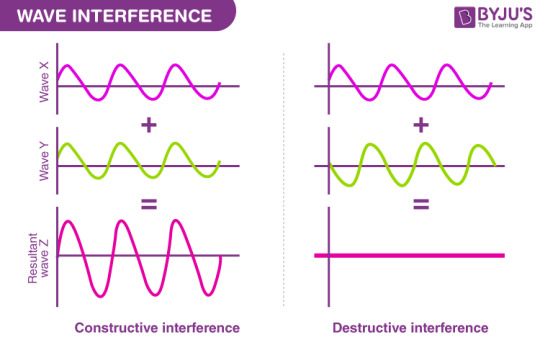
By extension deciding this also made it easier to understand why or how some things can detect magic (they'd pick up on the weird frequencies) AND how it's possible to have magic blocking devices (they emit destructive frequencies that nullify it). Does it fully make sense on a physical level? Not necessarily but I get giddy when I can visualise magic mechanics like this hehe
The other decision was to simplify our lineup of humanoid species from the original DnD esque basis, but in a way that allows us to have basically any humanoid appearance you can think of through a ✨mutation✨ cheatcode. We have two "elf" subspecies (basically the dark elf-like ppl and everyone else, including "dwarf" looking folk, etc) and then a species that technically derives from them (and they're all genetically compatible) that's characterised by having abnormal, often insect-like traits. There's no real limit to their phenotypes since their origin is magical and random in nature, and since they can mix with "normal" elves the degree of bugness varies.
Which means i can have insect people, reptile people, horns or hooves or tails or wings galore without needing to come up with a full background for each of these variants >:)c
ANYHOO sorry I get carried away rambling about these things. Class-wise, I only have claims for some characters who... may be yet to make a full appearance in the comic, and would actually fight:
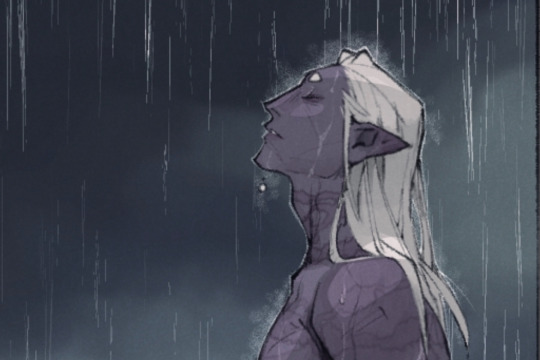
^ Monk??? Not my first claim but after playing an actual monk the ki system started making a lot of sense

^ Lil' sorcerer u_u probably with a subclass or two but sorcerer would hold up as he grows older

^ I think warlock would work for her well enough. Not a perfect fit but I can see it with some homebrew tweaking
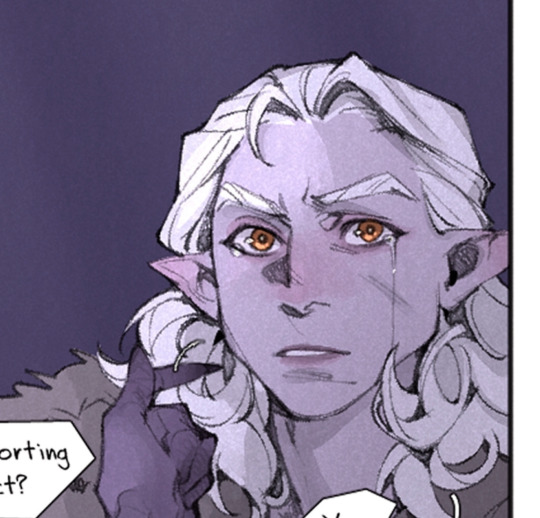
^ Ranger makes sense I feel, she becomes one with the avalanches

^ Barbarian.... barbarian/druid???? Uncharted territory here

^ Warlock but you haven't seen much of it yet.... soon.... (I'm actually so excited for her)

^ This one's easy I just snatched her straight from an old DnD game anyway. That's my rogue artificer babygirl
Anyhoo hope you enjoyed this ramble
184 notes
·
View notes
Text
IT IS DONE
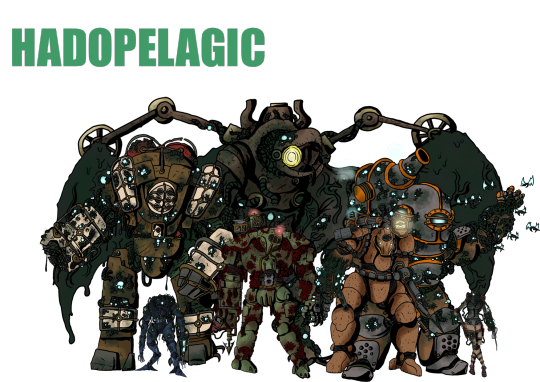
The Hadopelagic LCP homebrew is finally done, with art and fluff by yours truly. LCP creation by @grave--accent and balancing, editing and general creation of all the important stats by @skaiandestiny I am proud to finally present this long in development homebrew faction to you. The LCP contains a brand new manufacturer, complete with licenses , systems, core bonuses, variant frames and plenty of lore to read through. Link here
The ZIP file contained within this link contains not only the LCP, but PNGs of all the mechs for use as tokens in game. Happy hunting and Happy New Year. (You may need to disable Darkreader to properly see the link once opened).
#my art#my artwork#lancer rpg#lancerrpg#lancer#lancer homebrew#hadopelagic#lancer hadopelagic#homebrew#lancer art
151 notes
·
View notes
Video
youtube
ZXRIS for the ZX81
#youtube#ZXRIS#ZX81#Action#Puzzle#Falling Blocks#Falling Blocks Puzzle#Tetris Clone#Tetris Variant#Homebrew#Homebrew Game#NICKMANN Studio
2 notes
·
View notes
Text
Edit: The Critical Role and Fathom pages for the Indianapolis liveshow still don't list Bells Hells as the party, nor does the description particularly implicate them. Variety may have messed up.
It's very interesting to learn that the Daggerheart in Exandria liveshow later this year is going to be starring Bells Hells. And I wonder how much, if any, homebrewing they're going to do to make it work.
Without having the final rules in front of me (yet), I can guess that some of the conversions will be fairly straightforward while others will get interesting.
For instance, Orym and Fearne and Braius's Ancestries are pretty straight to convert. Orym is still a halfling, Fearne still a faun (satyr), and Braius gets the firbolg: minotaur aesthetic variant.
(Or Fearne might get a faun and faerie mix for Luck Bender as a Fatestitching nod)
And while Imogen and Laudna seem fairly straightforward to go with a human Ancestry, I'd honestly consider mixing them. Maybe add fungril to both, really, but in different combinations. Imogen would get the Fungril Network ability reskinned for Ruidusborn mindreading, while I think the Death Connection would be suited to Laudna.
Chetney and Ashton provide more of a challenge in Ancestry though, since gnomes and genasi have no essentially direct matches.
For Chetney, I think I would mix clank Purposeful Design (+1 to an experience) on the basis of he's old and dedicated to his profession with katari Retracting Claws as a nod to the lycanthropy.
For Ashton, I'd probably mix faerie Luck Bender for dunamis flavoring, with giant Endurance or orc Sturdy for a little barbarian hardiness flavor.
And that's not even getting into Class and Domain Cards. But I think I'll save that speculation for next week when I've got my copy of Daggerheart's final rules to pull from instead of the open beta version.
44 notes
·
View notes
Note
I still believe the craziest form of computer program storage format from the 1980s is the cassette tape. Logical I get it but to store entire programs on little tape (that I only remember using to play music) is just crazy to me. Idk
Agreed, cassette tape for data storage was really clever. The concept had its heyday was the 1970s in a wide variety of encoding schemes for different computer platforms. It did persist into the 80s, mostly in Europe, while the US switched to floppy disks as soon as they were available for systems. The majority of my Ohio Scientific software is on cassette.

Talking with UK vs. US Commodore 64 users in particular will highlight the disparity in which storage mediums that were commonplace. I've got a few pieces of software on tape for mainly the VIC-20, but I rarely bother to use it, because it's slow and annoying. To be fair, Commodore's implementation of data storage on tape is pretty rock solid relative to the competition. It's considered more reliable than other company's but Chuck Peddle's implementation of the cassette routines are considered quite enigmatic to this day. He didn't document it super well, so CBM kept reusing his old code from the PET all the way through the end of the C128's development 7 years later because they didn't want to break any backward compatibility.

The big thing that really made alot of homebrewers and kit computer owners cozy up to the idea was the introduction of the Kansas City Standard from 1976. The idea of getting away from delicate and slow paper tape, and moving towards an inexpensive, portable, and more durable storage medium was quite enticing. Floppy disk drives and interfaces were expensive at the time, so something more accessible like off the shelf audio tapes made sense.
I've linked two places you can read about it from Byte Magazine's February 1976 issue below (check the attribution links).
You might recognize a familiar name present...
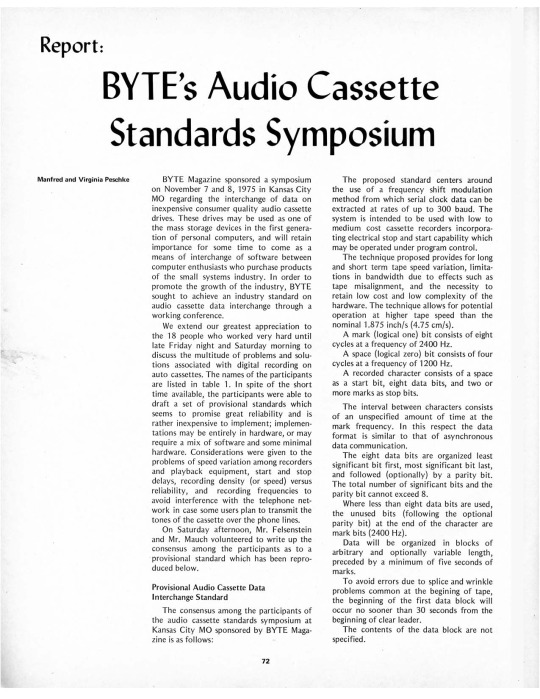
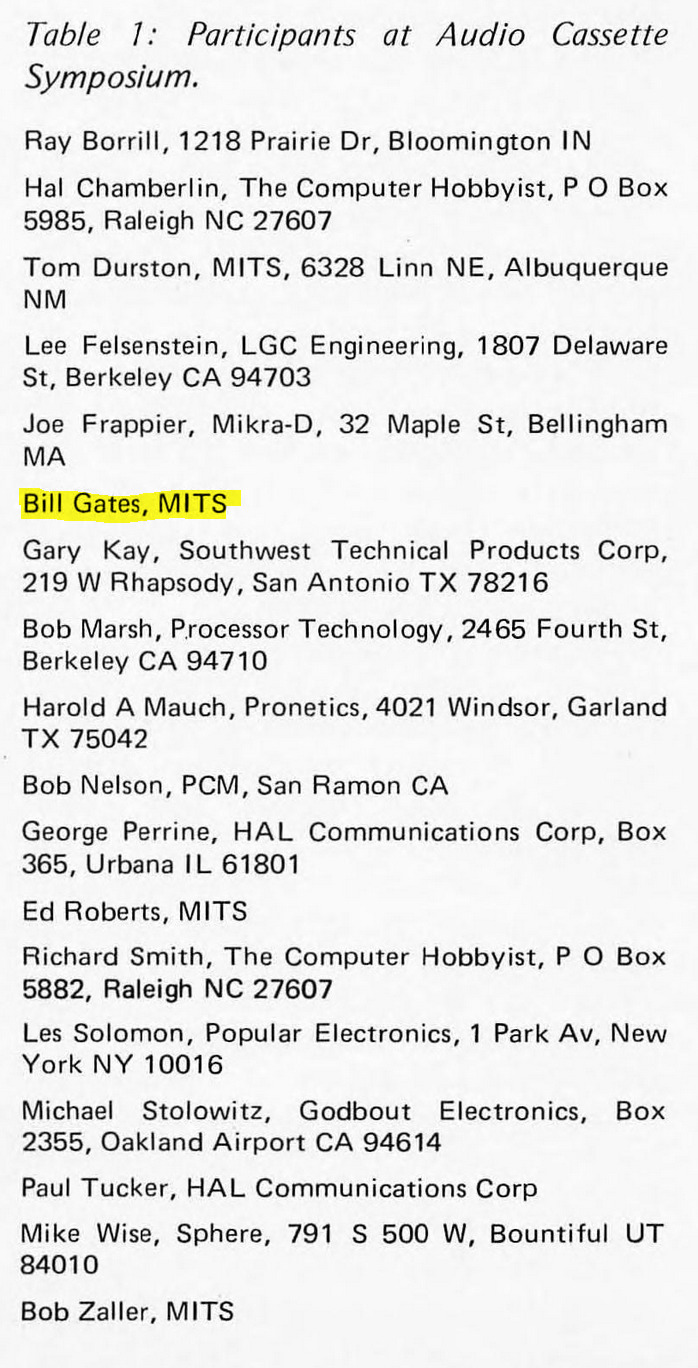
There are a few ways to encode binary data on tape designed to handle analog audio, but the KCS approach is to have 1's be 8 cycles of 2400Hz tone, and 0's be 4 cycles of 1200Hz tone. I say cycles, because while 300 baud is the initial specification, there is also a 1200 baud specification available, so the duration of marks vs spaces (another way of saying 1's and 0's), is variable based on that baud rate. Many S-100 computers implemented it, as do a few contemporary proprietary designs.
The big 3 microcomputers of 1977 that revolutionized the industry (Apple II, Commodore PET 2001, and Tandy TRS-80 Model I) each have their own cassette interface implementation. It kept costs down, and it was easy to implement, all things considered. The Apple II and TRS-80 use off-the-shelf cassette deck connections like many other machines, whereas the original variant of the PET had an integrated cassette. Commodore later used external cassette decks with a proprietary connector, whereas many other companies abandoned tape before too long. Hell, even the original IBM PC has a cassette port, not that anybody bothered to use that. Each one used a different encoding format to store their data, rather than KCS.
Here's a sample of what an OSI-formatted tape sounds like.
And here's a Commodore formatted tape, specifically one with VIC-20 programs on it.
I won't subject you to the whole program, or we'd be here all day. The initial single tone that starts the segment is called the "leader", I've truncated it for the sake of your ears, as well as recorded them kinda quietly. I don't have any other tape formats on hand to demonstrate, but I think you get the idea.
You can do alot better than storing programs on tape, but you can also do alot worse -- it beats having to type in a program every time from scratch.
273 notes
·
View notes